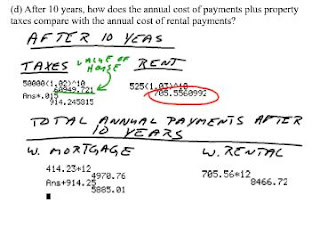sorry if i don't cover everything in today's scribe. I'm having problems with my computer and had no idea was scribe for today.OK so today was the first day of our
Periodic Functions unit.
To day we looked at the circle, and why there are
360° in a circle. The reason is that
360° is divisible by many numbers, and ever though measuring a circle with
400° may be easier, it cant be divided by as many numbers as
360°.
let me show you (note this symbol † mean divisible by )
360°†
1, 2, 3, 4, 5, 6, 10, 12, 15, 18, 20, 24, 30, 36, 40, 45, 60, 77, 90, 120, 180, 360400°†
1, 2, 4, 5, 8, 10, 16, 20, 25, 40, 50, 80, 100, 200, 400as you can see,
360 is divisible by a lot more numbers
Next we learned that we measure a certain way, and even though measuring in Jhay-Ar's sounds kinda cool, not everyone knows what it is. So we use
radians.
If you take the radius of a circle and measure it around the circumference of half a circle you will notice that it fits exactly the number of π around the half circle. 3.145 .....
This is a radian measurement
it is usually expressed π/ x
half of a circle is
180°.
180° degrees = π
That is why we measure in π. π can also translate into degrees on a circle.
For example
π/2 is half of the circle and since 180° = π then 180/2 is 90° which is half of a circleπ/3 is one third of a circle, 180° = π then 180°/3 is 60°π/4 is one quarter of the circle there fore 180°/4 is 45°π/x is a radian measurementbut what about degrees higher than 90°?
lets try
2π/3well since 180°=π we can substitute π with 180 °
2(280°)/3
2(60°)
120°
the degree is 120°
Here is the diagram. from the slides

OK we in the after noon we were given questions and equations
the equation that we were given was
R/
π =
D/
180°r represents Radianπ represents πD represents Degree and 180° represents 180 °π still = 180°
So the first question we were given was
Find 250° in radians
we solved like this...
r/π = d/180°
r/π=250°/180°
180°r/180° = 250°π/180°
simplify to r=25π/18°
so we just plugged the degree into the right place and crossed multiplied and then simplified
Next Find 3π/8 in degrees
The class solved it this way
d/180°= 3π/8/π
πd/π=180° (3π/8)/π
d=180°(3π/8)/π
d=67.5°
now to me this is a bit much, because of the complex fraction ( a fraction within a fraction ) that and fractions make me angry.
So the way i did it was...
if π is equal to 180° degrees then replace π with 180°
3(180°)/8
3(22.5°)
=67.5°
Both ways are correct, being the lazy person i am, i found a short cut. It just turned out to be a good one, he he.
we also learned what a periodic is. A periodic is something that repeats a rhythm, or a patter. Like the clock, the second hand on a clock will reach its lowest point ( at the 6 ) say now, and reach its highest point (at the 12 ) 30 seconds from now, and then its lowest 30 seconds from then, then reach its lowest point 30 seconds from then and so on and so on. and it never stops. The same thing with the minute hand, excepts its in minutes. and again with the hour hand, except it takes hours. the same thing can be said about a planet, or its moon. It reaches its maximum high at one point and then its minimum point another time and so on. You can find periodical patterns like this everywhere. In a heart beat, seasons, ocean tides, nature and so much more.We learned this so we could start our homework assignment, the sine curve (graph) thing. Its a hand out so if you didn't get it, ask Mr.K for it.
We leads me to the end of class. Just after the bell we watched a Math parody rap. Called
"whatcha no 'bout math". It was kinda funny, i liked it. I wont link it, but of you want to watch it youtube search
"whatcha know 'bout math"hasta luego.
By the way i think I'm the last one on this cycle so there for a new cycle must begin. I suppose ( and if I'm right I'm not sure ... ) the next scribe will be.... mm mm
☺☺☺CRIS_JOHN ☺☺☺
(extra note the ☺ code ALT+1 , if you didn't know)

























 The first question asked "How does it take for the spaceship to go around the earth."
The first question asked "How does it take for the spaceship to go around the earth."














